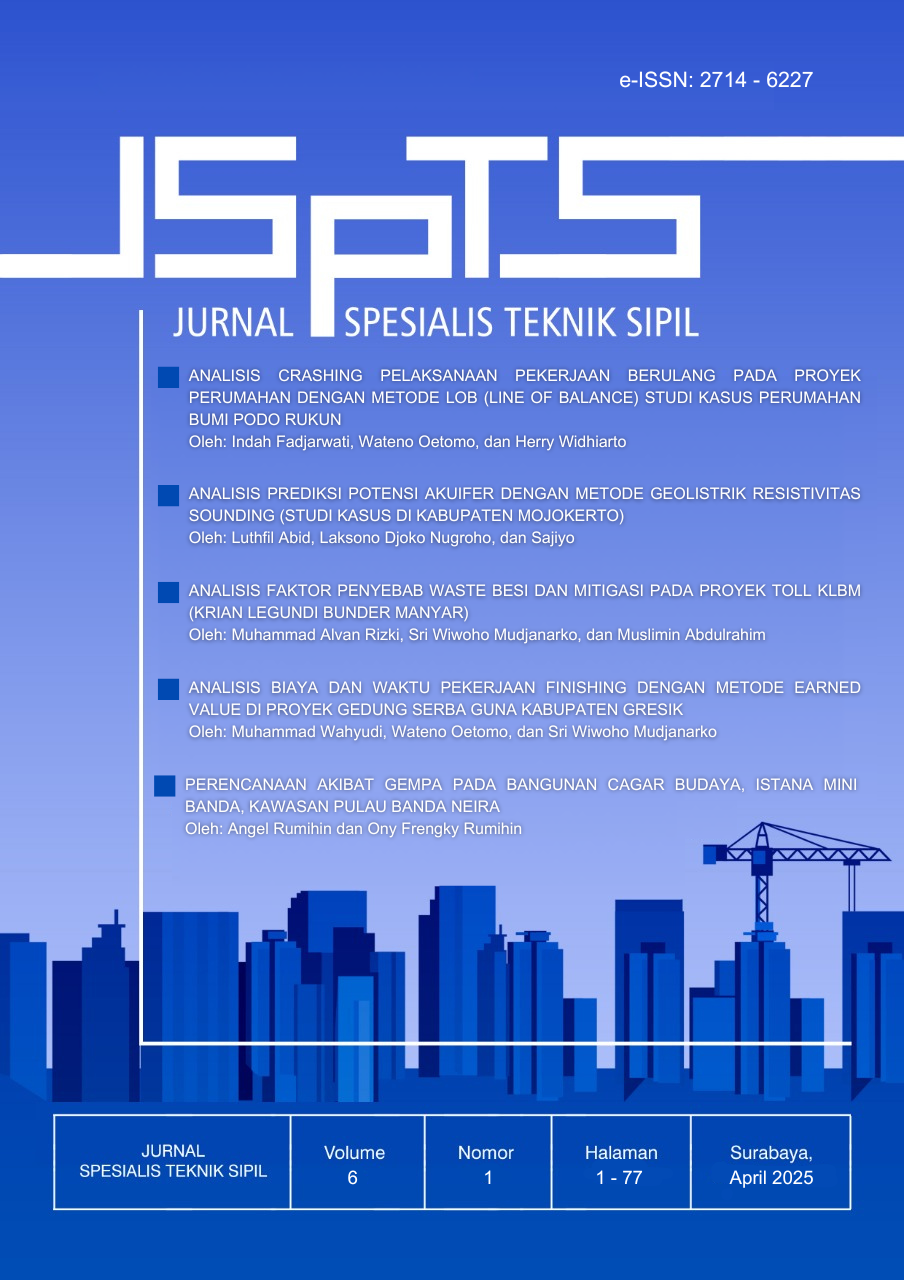Crashing Analysis of Repeated Work Implementation on Housing Projects Using the LoB (Line of Balance) Method Case Study of Bumi Podo Rukun Housing
Keywords:
Line of Balance, LoB Method
Abstract
Housing construction is a recurring and sustainable job. So if the scheduling does not take into account the character of this work then the repetitive work unit will experience a delay (lag). So that it will result in the duration of the project. To overcome this, an uninterrupted scheduling method is needed from one unit to the next. The scheduling method that matches this type of repetitive work is the Line of Balance (LoB) because each activity / activity is described in a straight line and the speed of work can be changed according to needs. This is to avoid the occurrence of crashes / conflicts between activities. This method can also minimize the delay time as mentioned above. But this method cannot show dependency between critical activities and the other activities. For this reason, another method is needed in order to fill this gap. The suitable method is CPM through Microsoft Project. This combination of methods besides managing the time of project implementation also regulates human resources, namely by maximizing the allocation of human resources. Because in this multi-unit project the quantity of work is the main thing. From some analysis calculations, the results obtained that the addition of buffers with productivity speed smoothing, and the acceleration of the duration of the activity more effective to accelerate the implementation time of the project with a duration of 154 days.Downloads
Download data is not yet available.
References
Bautz, Kevin. 2016. Kevin Bautz. Triple Constraint : Fast, Good, Cheap (Speed, High Quality, Low Cost). http://hm-ec.com/blog/
Soeharto I, Iman. 1998. Manajemen ProyekDari Konseptual SampaiOperasional. Konsep , Studi Kelayakan, dan Jaringan Kerja Jakarta: Erlangga.
Frederika, Ariany. Analisis Percepatan dengan menambah Jam Kerja Optimum Pada Proyek Konstruksi ( Studi kasus: Proyek Pembangunan Super Villa, Peti Tenget-Bandung). Jurnal Ilmiah Teknik Sipil, [S.I.], nov. 2012.ISSN 2541-5484. Available at: https://ojs.unud.ac.id/index.phd/jits/article/view/3653>. Date accesed 29 June 2019.
Triana, D., 2004, Analisis Metode Crashing Dalam Perencanaan Waktu dan Biaya Proyek Konstruksi (Studi Kasus Proyek Pembangunan Jembatan Pasir Keranji Indragiri Hulu), Universitas Islam Indonesia, Yogyakarta.
Ervianto, Wulfram I. 2002. Manajemen Proyek Konstruksi. Andi: Yogyakarta.
Muchdarsyah Sinungan, 1992. Produktivitas, apa dan bagaimana. Bumi Aksara. Jakarta.
Kusrianto, Adi. 2008. Panduan lengkap memakai Microsoft Project 2007. Jakarta: PT. Elex Media Komputindo.
Lockyer, Keith. Muhlemann, Alan dan Oakland, John. 1994. Manajemen Produksi dan Operasi. Edisi ke lima. Jakarta : Elex Media Komputindo.
Mawdesley, M.J.,Askew, W.H., O’Reilly,M., 1997. Planning and Controlling Construction Project, The Chartered Institute of Building, England.
Harris, Robert B and Ioannou. 1998, Repetitive Scheduling Project, Report N0.98 Civil and Environmental Engineering Department University of Michigan.
Uher, T.E., 1996. Programming and Schedulling Techniques. Constuction Project Management and Economic Unit, School of Building, University of New South Wales, Australia.
Callahan, M.T., D.G. Quackenbush, and J.E.Rowings. 1992. Construction Project Schedulling. Singapore: McGraw-Hill.
Setiawan, Antonius F., 2008. Smart Project Plan with Microsoft Office Project 2007. PC. Media. Jakarta.
Wahana Komputer, 2008. Pengelolaan Proyek dengan Microsoft Office Project 2007, Penerbit Andi, Yogyakarta.
Heizer, Jay dan Barry Render, 2005, Operations Management, Edisi 7, Penerjemah: Dwianoegrahwati S dan Indra Almahdy, Jakarta: Salemba Empat.
Su, Y., Lucko, G., 2015. Comparison and Renaissance of Classic Line-of-Balance and Linear Schedule Concept for Construction Industry, DOI 10.5592 Reseach Paper 1315-1329.
Pai, S.K., Verguese, P., Rai, S., 2013. Application of Line of Balance Scheduling Technique (LOBST) for Real Estate Sector, International Jurnal of Science, Engineering and Technology Reseach (IJSETR) Volume 2, Issue 1, 82-95.
Soeharto I, Iman. 1998. Manajemen ProyekDari Konseptual SampaiOperasional. Konsep , Studi Kelayakan, dan Jaringan Kerja Jakarta: Erlangga.
Frederika, Ariany. Analisis Percepatan dengan menambah Jam Kerja Optimum Pada Proyek Konstruksi ( Studi kasus: Proyek Pembangunan Super Villa, Peti Tenget-Bandung). Jurnal Ilmiah Teknik Sipil, [S.I.], nov. 2012.ISSN 2541-5484. Available at: https://ojs.unud.ac.id/index.phd/jits/article/view/3653>. Date accesed 29 June 2019.
Triana, D., 2004, Analisis Metode Crashing Dalam Perencanaan Waktu dan Biaya Proyek Konstruksi (Studi Kasus Proyek Pembangunan Jembatan Pasir Keranji Indragiri Hulu), Universitas Islam Indonesia, Yogyakarta.
Ervianto, Wulfram I. 2002. Manajemen Proyek Konstruksi. Andi: Yogyakarta.
Muchdarsyah Sinungan, 1992. Produktivitas, apa dan bagaimana. Bumi Aksara. Jakarta.
Kusrianto, Adi. 2008. Panduan lengkap memakai Microsoft Project 2007. Jakarta: PT. Elex Media Komputindo.
Lockyer, Keith. Muhlemann, Alan dan Oakland, John. 1994. Manajemen Produksi dan Operasi. Edisi ke lima. Jakarta : Elex Media Komputindo.
Mawdesley, M.J.,Askew, W.H., O’Reilly,M., 1997. Planning and Controlling Construction Project, The Chartered Institute of Building, England.
Harris, Robert B and Ioannou. 1998, Repetitive Scheduling Project, Report N0.98 Civil and Environmental Engineering Department University of Michigan.
Uher, T.E., 1996. Programming and Schedulling Techniques. Constuction Project Management and Economic Unit, School of Building, University of New South Wales, Australia.
Callahan, M.T., D.G. Quackenbush, and J.E.Rowings. 1992. Construction Project Schedulling. Singapore: McGraw-Hill.
Setiawan, Antonius F., 2008. Smart Project Plan with Microsoft Office Project 2007. PC. Media. Jakarta.
Wahana Komputer, 2008. Pengelolaan Proyek dengan Microsoft Office Project 2007, Penerbit Andi, Yogyakarta.
Heizer, Jay dan Barry Render, 2005, Operations Management, Edisi 7, Penerjemah: Dwianoegrahwati S dan Indra Almahdy, Jakarta: Salemba Empat.
Su, Y., Lucko, G., 2015. Comparison and Renaissance of Classic Line-of-Balance and Linear Schedule Concept for Construction Industry, DOI 10.5592 Reseach Paper 1315-1329.
Pai, S.K., Verguese, P., Rai, S., 2013. Application of Line of Balance Scheduling Technique (LOBST) for Real Estate Sector, International Jurnal of Science, Engineering and Technology Reseach (IJSETR) Volume 2, Issue 1, 82-95.

Published
2025-04-29
Issue
Section
Articles
Copyright (c) 2025 Jurnal Spesialis Teknik Sipil (JSpTS)

This work is licensed under a Creative Commons Attribution 4.0 International License.







